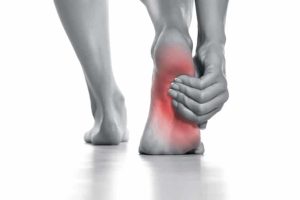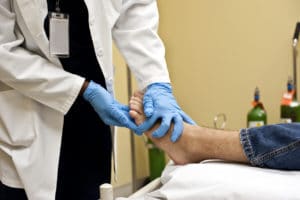Information From The American Podiatric Medical Association
What are the causes of Heel Pain?
 In our pursuit of healthy bodies, pain can be an enemy. In some instances, however, it is of biological benefit. Pain that occurs right after an injury or early in an illness may play a protective role, often warning us about the damage we've suffered.
In our pursuit of healthy bodies, pain can be an enemy. In some instances, however, it is of biological benefit. Pain that occurs right after an injury or early in an illness may play a protective role, often warning us about the damage we've suffered.
When we sprain an ankle, for example, the pain warns us that the ligament and soft tissues may be frayed and bruised, and that further activity may cause additional injury.
Pain, such as may occur in our heels, also alerts us to seek medical attention. This alert is of utmost importance because of the many afflictions that contribute to heel pain.
At the Precision Foot and Ankle, our team of experienced podiatrists will assess your heel pain and provide a diagnosis and treatment plan that will get you back to looking and feeling your best in no time.
Heel Pain Treatment
Heel pain is generally the result of faulty biomechanics (walking gait abnormalities) that place too much stress on the heel bone and the soft tissues that attach to it. The stress may also result from injury, or a bruise incurred while walking, running, or jumping on hard surfaces; wearing poorly constructed footwear; or being overweight.
The heel bone is the largest of the 26 bones in the human foot, which also has 33 joints and a network of more than 100 tendons, muscles, and ligaments. Like all bones, it is subject to outside influences that can affect its integrity and its ability to keep us on our feet. Heel pain, sometimes disabling, can occur in the front, back, or bottom of the heel
Prevention
A variety of steps can be taken to avoid heel pain and accompanying afflictions:
- Wear shoes that fit well—front, back, and sides—and have shock-absorbent soles, rigid shanks, and supportive heel counters.
- Wear the proper shoes for each activity.
- Do not wear shoes with excessive wear on heels or soles.
- Prepare properly before exercising. Warm up and do stretching exercises before and after running.
- Pace yourself when you participate in athletic activities.
- Don’t underestimate your body's need for rest and good nutrition.
- If obese, lose weight.
What is Podiatric Medical Care?
 If pain and other symptoms of inflammation—redness, swelling, heat—persist, you should limit normal daily activities and contact a doctor of podiatric medicine.
If pain and other symptoms of inflammation—redness, swelling, heat—persist, you should limit normal daily activities and contact a doctor of podiatric medicine.
At the Precision Foot and Ankle, one of our podiatrists will examine your heel pain and may perform diagnostic X-rays to rule out problems of the bone.
Heel Pain Treatment In Utah
Heel pain treatment at our Utah offices might involve oral or injectable anti-inflammatory medication, exercise and shoe recommendations, taping or strapping, or use of shoe inserts or orthotic devices. Taping or strapping supports the foot, placing stressed muscles and tendons in a physiologically restful state. Physical therapy may be used in conjunction with such treatments.
A functional orthotic device may be prescribed for correcting biomechanical imbalance, controlling excessive pronation, and supporting of the ligaments and tendons attaching to the heel bone. It will effectively treat the majority of heel and arch pain without the need for surgery.
Only a relatively few cases of heel pain require more advanced treatments or surgery. If surgery is necessary, it may involve the release of the plantar fascia, removal of a spur, removal of a bursa, or removal of a neuroma or other soft-tissue growth.
What People Say
What are Some Common Causes of Heel Pain?
Usually, heel pain is a result of a common condition called plantar fasciitis. The plantar fascia is a strong ligament that runs from just under the toes to the heel. Certain conditions can cause this ligament to become inflamed and painful. Pain may center on the ball of the foot or the heel, and can last for many months until the plantar fascia recovers. Pain may also occur when inflammation is present in the bursa of the heel or the Achilles tendon. In children and teens, heel pain may result from micro-injuries to the heel during a growth spurt. Finally, calcium deposits can develop on the underside of the heel, causing ongoing pain.
What Should I Do if I Sprain My Ankle?
As long as your ankle injury is not severe, you can apply self-care to help the are recover. Recommended self-care for an ankle sprain includes the following:
- Apply a bandage to gently compress the area and support it when walking.
- Use assistance for walking as needed, such as a cane or crutches. This will help keep unnecessary pressure off the ankle.
- Elevate the foot when possible, at least a few times a day.
- Apply an ice pack to the ankle for about 15 minutes at a time. You can do this up to several times a day.
- Take an anti-inflammatory medication to reduce swelling and pain.
- See a doctor if the pain or swelling worsens or does not improve after about one week of rest.
How Can I Care for My Feet When I have Diabetes?
Diabetes can have severe effects on the feet. It is imperative that you learn how to care for your toenails and feet properly if you have diabetes. General recommendations for diabetic foot care include:
- Wash feet daily in lukewarm water
- Use a soft cloth to wash your feet, then pat them dry
- Apply lotion, but NOT in between your toes
- When washing and drying, observe all areas of each foot for signs of callouses, sores, cuts, and other hazards
- Keep your toenails trimmed and filed at the edges
- Check the insides of shoes before putting them on
- Refrain from walking barefoot as much as possible
- Have your feet checked by your doctor every so often
What Kinds of Sports Injuries Do You Treat?
Precision Foot and Ankle offers personal care delivered by experienced doctors. Our team has extensive training in the field of podiatry that enables them to address foot injuries incurred during just about any sport. Some of the most common injuries that we treat include sprained ankles, ankle fractures, plantar fasciitis, stress fractures of the foot, and Achilles tendonitis.
What Causes Pain in the Arch of the Foot?
Like heel pain, it is an inflamed plantar fascia ligament that is behind most cases of arch pain. Additional reasons that pain may localize in the arch of the foot include flat feet and abnormal pronation. Having flat feet means that your arches are not curved normally, that the entire bottom of your foot rests on the floor. Flat feet may result from abnormal development or from injury, overuse, or obesity. Your foot pronation is the angle of slant when you take a step. With each step, your foot should lean slightly inward, toward the arch. Sometimes, this lean goes too far inward, or, conversely, your foot may lean outward. This disrupts the biomechanics of your gait, resulting in pain.
What is a Hammertoe?
A hammertoe is a toe that is bent due to the abnormal position of the surrounding muscles and tendons. These structures can pull the middle joint of the toe out of alignment, causing curling or permanent deformity. In severe cases, a hammertoe requires surgical repair.
Heel Pain Tips
- If you have experienced painful heels try wearing your shoes around your house in the evening. Don't wear slippers or socks or go barefoot. You may also try gentle calf stretches for 20 to 30 seconds on each leg. This is best done barefoot, leaning forward towards a wall with one foot forward and one foot back.
- If the pain persists longer than one month, you should visit a podiatrist for evaluation and treatment. Your feet should not hurt, and professional podiatric care may be required to help relieve your discomfort.
- If you have not exercised in a long time, consult your podiatric physician before starting a new exercise program.
- Begin an exercise program slowly. Don't go too far or too fast.
- Purchase and maintain good shoes and replace them regularly.
- Stretch each foot and achilles tendon before and after exercise.
- Avoid uneven walking surfaces or stepping on rocks as much as possible.
- Avoid going barefoot on hard surfaces.
- Vary the incline on a treadmill during exercise. Nobody walks uphill all the time.
- If it hurts, stop. Don't try to "work through the pain."
Click here to learn more about our services!
The Doctors at the Precision Foot and Ankle have been trained specifically and extensively in the diagnosis and treatment of all manner of foot conditions. This training encompasses all of the intricately related systems and structures of the foot and lower leg including neurological, circulatory, skin, and the musculoskeletal system, which includes bones, joints, ligaments, tendons, muscles, and nerves.
Schedule An Appointment
If you are experiencing heel pain in Utah, call one of our offices or click the button below to schedule an appointment online. We have offices in Payson, American Fork, Orem, and Payson, UT.

